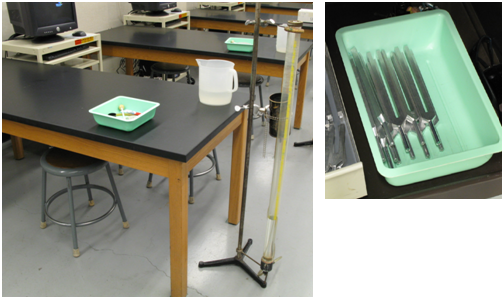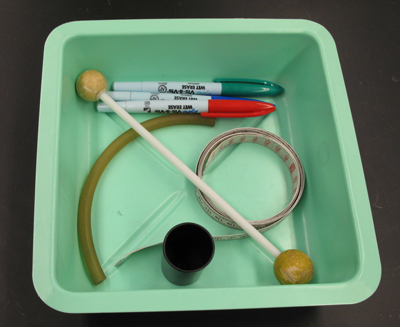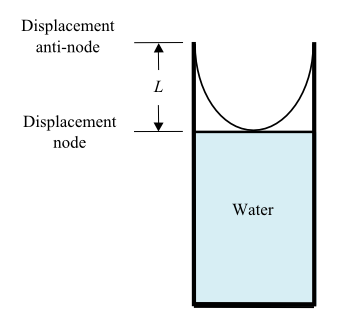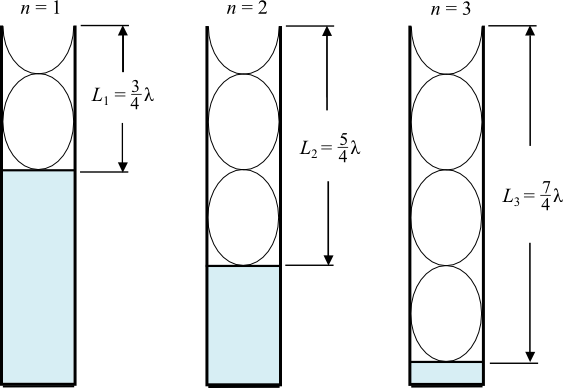Speed of Sound - Resonance Tube
Back to TopObjectives
-
•to determine the speed of sound waves in air
Equipment
resonance tube, tuning forks, rubber mallet, measuring tape, thermometer
Figure 1

Figure 2
Introduction and Theory
A sound wave is a longitudinal wave in which the wave oscillates along the direction of propagation. For a traveling wave of speed v, frequency f, and wavelength λ, the following relationship holds. In this lab, we are going to use a simple characteristic of the traveling wave—the resonance—to determine the wavelength (and therefore the speed) of a sound wave. Consider a sound wave traveling through a resonance tube as illustrated in Fig. 3.
Figure 3: Resonance tube
v = fλ
, the wavelength of the sound wave should also be fixed. As a result, the resonance conditions can only be satisfied when the length of the tube L is such that
where n = 0, 1, 2, 3, 4,..., and the length Ln is defined to be the distance measured from the open end of the tube to the water surface. For the specific example given in Fig. 3, the first resonance is shown, when n = 0, and from equation 2, the length of the tube is L =
λ.
Fig. 4 shows resonance conditions in which n = 1, 2, and 3 (resonance 2, 3, and 4). It is easy to notice that | 1 |
| 4 |
L2 − L1 =
λ
| 1 |
| 2 |
and L3 − L2 =
λ.
It can be predicted that the next resonance will occur at | 1 |
| 2 |
L4 =
λ +
λ =
λ.
In other words, we have the following equations.
This relationship between the two consecutive resonances will be used to find the wavelength of the standing sound wave.
The objective of this lab is to measure the speed of a sound wave in the air and compare it to its theoretical value.
| 7 |
| 4 |
| 1 |
| 2 |
| 9 |
| 4 |

Figure 4: Examples of resonance for n = 1, 2, and 3
Video
View the video below prior to beginning your lab.Procedure
Please print the worksheet for this lab. Answer all the questions on the Lab Worksheet prior to submitting the Inlab in WebAssign.Checkpoint:
Be sure to have your TA sign your lab worksheet, printed Inlab, and all printed graphs after each part is completed. Be sure the data can be seen on the graphs.
Be sure to have your TA sign your lab worksheet, printed Inlab, and all printed graphs after each part is completed. Be sure the data can be seen on the graphs.
Watch the level of water in the side container to avoid overflowing. Be sure to clean up any spills.
1
You will be provided with two tuning forks of known frequencies f. Note that the frequencies of the tuning forks are marked on them. Record them in the Inlab in WebAssign.
2
Fill the tube with water to about 10 cm from the open end of the tube. The level of the water in the tube (= the length of the tube L) can be adjusted by moving the side bucket up and down in the vertical direction.
3
Strike the tuning fork with the rubber head of the mallet for forks with frequencies below 1000 Hz
or with the wooden head for forks with frequencies above 1000 Hz, and place it just above the open end of the tube. Neither the hammer nor the vibrating fork should touch the tube.
4
Find as many resonances as you can for the first tuning fork. Repeat your measurements by increasing the water level in the tube. Measure the length of the air column for each resonance from the top edge of the tube. Find the difference in length (ΔL) between the two consecutive resonances to calculate the wavelength of the sound wave. Once the wavelength is determined, the speed of sound follows from equation 1v = fλ
. (Note that the error in the measurement of the length is 1 mm.)
5
Repeat steps 3–4 for the other tuning fork with a different frequency.
In the Inlab, you will need to calculate the average of the two measured speeds of sound and compare them to the theoretical value.

